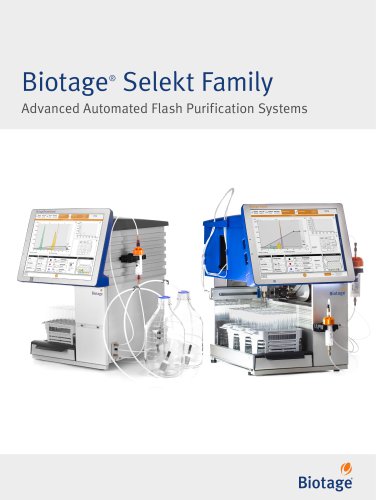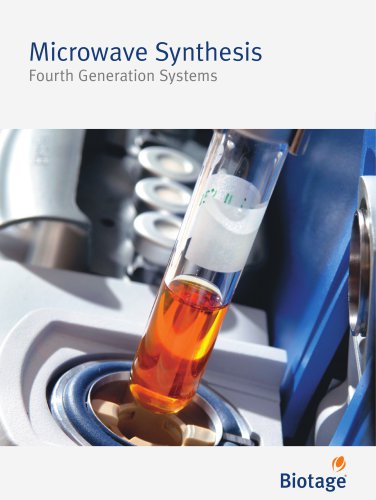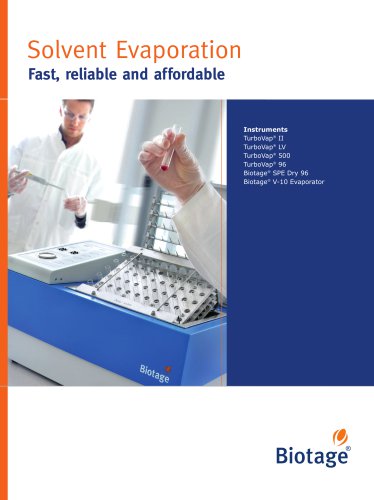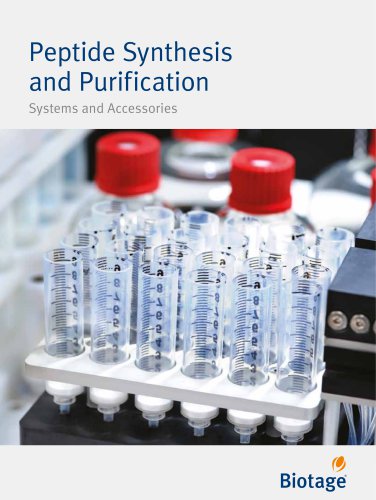 Website:
BIOTAGE
Website:
BIOTAGE
Group: Biotage India Private Limited
Catalog excerpts

Clear Selection Main Menu
Open the catalog to page 1
CONTENTS 1 Initiate Success in Chemical Education with Microwave Assisted Organic Synthesis 3 Oxidation of Alcohol to Ketone with MnO2 4 Reduction of Aldehyde to Alcohol with MP-BH4 5 Solvent-Free Amide Bond Formation 6 2-Step Reaction 1: Suzuki reaction and Catalytic Transfer Hydrogenation 7 Step 2: Catalytic Transfer Hydrogenation 8 2-Step Reaction 2: Diels-Alder Cycloaddition and Imide Formation 9 Step 2: Imide formation 10 3-Component Reaction 11 Hantzsch, 3-Component Reaction 12 Nucleophilic Aromatic Substitution 13 Reductive Amination 14 Peptide Coupling 15 Epoxide Opening 16...
Open the catalog to page 2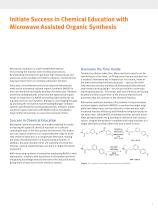
Initiate Success in Chemical Education with Microwave Assisted Organic Synthesis Microwave irradiation is a well-established method of increasing the reaction rate of chemical processes. By employing microwaves to generate high temperatures and pressures under carefully controlled conditions, chemistry that may have taken hours is routinely achieved in minutes. Every year, more pharmaceutical and industrial laboratories make use of microwave assisted organic synthesis (MAOS) to trial new reactions and rapidly develop new molecules. However, university undergraduates rarely have the...
Open the catalog to page 3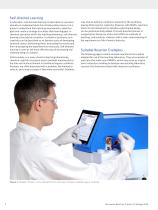
Self-directed Learning In education, self-directed learning is described as a process whereby an individual takes the initiative either alone or in a group to understand their learning requirements, identify a path and create a strategy to achieve their learning goal. In chemical education within the teaching laboratory, self-directed learning is focused on creativity. In chemical synthesis such creativity can be described as an iterative cycle of developing synthetic routes, performing them, evaluating the results and then re-designing the experiment as necessary. Self-directed learning is...
Open the catalog to page 4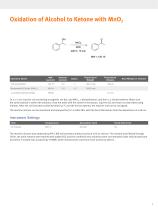
Chemical Name (g/mol) (mmol) quiv. Weight Theoretical Volume Real Weight or Volume To a 2-5 mL reaction vial containing a magnetic stir bar, add MnO2, 1-phenylethanol, and then 1,2-dichloroethane. Make sure the solid material is within the solution; rinse the walls with the solvent if necessary. Cap the vial and heat it as described using Initiator. After the vial has been cooled to below 50 °C and the lid has opened, the reaction vial can be uncapped. The reaction mixture can be monitored and analyzed by TLC or HPLC-MS, with the best information from the absorbance at 208 nm. Time...
Open the catalog to page 5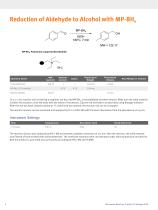
Chemical Name Amount (mmol) Theoretical Weight Theoretical Volume Real Weight or Volume Ethanol (EtOH) To a 2-5 mL reaction vial containing a magnetic stir bar, add MP-BH4, p-tolualdehyde and then ethanol. Make sure the solid material is within the solution; rinse the walls with the solvent if necessary. Cap the vial and heat it as described using Biotage® Initiator+. After the vial has been cooled to below 50 °C and the lid has opened, the reaction vial can be uncapped. The reaction mixture can be monitored and analyzed by TLC or HPLC-MS with the best information from the absorbance at 215...
Open the catalog to page 6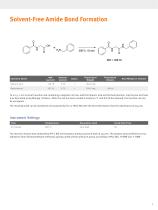
Chemical Name Amount (mmol) Theoretical Weight Theoretical Volume Real Weight or Volume To a 0.5-2 mL (conical) reaction vial containing a magnetic stir bar, add the hippuric acid and the benzylamine. Cap the vial and heat it as described using Biotage® Initiator+. After the vial has been cooled to below 50 °C and the lid has opened, the reaction vial can be uncapped. The resulting solid can be monitored and analyzed by TLC or HPLC-MS with the best information from the absorbance at 254 nm. Time Temperature Absorption level Fixed Hold Time 10 minutes 200 °C Very High On The reaction mixture...
Open the catalog to page 7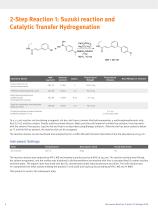
Chemical Name (g/mol) (mmol) Theoretical Weight Theoretical Volume Real Weight or Volume trans-3-Bromo-N-ethylcinnamamide 4-Methoxyphenylboronic acid Bis(triphenylphosphine) palladium(II) chloride((Ph3P)2PdCl2) Sodium carbonate monohydrate (Na2CO3*H2O) Dimethoxyethanol/water/ethanol (DME/H2O/EtOH) 7:3:2 To a 2-5 mL reaction vial containing a magnetic stir bar, add frans-3-bromo-W-ethylcinnamamide, 4-methoxyphenylboronic acid, Na2CO3*H2O and the catalyst. Finally, add the solvent mixture. Make sure the solid material is within the solution; rinse the walls with the solvent if necessary. Cap...
Open the catalog to page 8
Chemical Name Amount (mmol) Theoretical Weight Theoretical Volume Real Weight or Volume To a 2-5 mL reaction vial containing a magnetic stir bar, add frans-3-(4-methoxyphenyl)-W-ethylcinnamamide, ammonium formate and palladium on charcoal. Finally, add the ethanol. Make sure the solid material is within the solution; rinse the walls with the solvent if necessary. Cap the vial and heat it as described using Biotage® Initiator+. After the vial has been cooled to below 50 °C and the lid has opened, the reaction vial can be uncapped. The reaction mixture can be monitored and analyzed by TLC or...
Open the catalog to page 9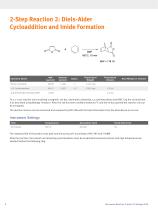
Chemical Name Maleic anhydride 1,3-Cyclohexadiene A/,A/-Dimethylformamide (DMF) (g/mol) (mmol) Theoretical Weight Theoretical Volume Real Weight or Volume To a 2-5 mL reaction vial containing a magnetic stir bar, add maleic anhydride, 1,3-cyclohexadiene and DMF. Cap the vial and heat it as described using Biotage® Initiator+. After the vial has been cooled to below 50 °C and the lid has opened the reaction vial can be uncapped. The reaction mixture can be monitored and analyzed by HPLC-MS with the best information from the absorbance at 200 nm. Time Temperature Absorption level Fixed Hold...
Open the catalog to page 10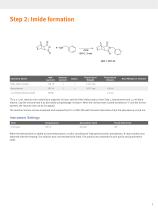
Chemical Name Amount (mmol) Theoretical Weight Theoretical Volume Real Weight or Volume TTo a 2-5 mL reaction vial containing a magnetic stir bar, add the Diels-Alder product from Step 1, benzylamine and 1,2-dichloro-ethane. Cap the vial and heat it as described using Biotage® Initiator+. After the vial has been cooled to below 50 °C and the lid has opened, the reaction vial can be uncapped. The reaction mixture can be monitored and analyzed by TLC or HPLC-MS with the best information from the absorbance at 208 nm. Time Temperature Absorption level Fixed Hold Time When the benzylamine is...
Open the catalog to page 11All BIOTAGE catalogs and technical brochures
-
Biotage® MP-TsOH
3 Pages
-
ISOLUTE® Si Trisamine
3 Pages
-
biotage selekt family
22 Pages
-
Microwave Synthesis
8 Pages
-
Solvent Evaporation
24 Pages
-
Flash Purification Systems
24 Pages




